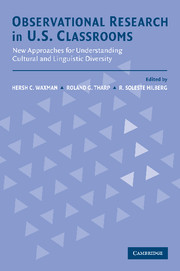 Observational Research in U.S. Classrooms
Observational Research in U.S. Classrooms Book contents
- Frontmatter
- Contents
- Tables, Figures, and Appendixes
- Contributors
- 1 Introduction: Purposes and Perspectives on Classroom Observation Research
- 2 Using Multiple Perspectives in Observations of Diverse Classrooms: The Sheltered Instruction Observation Protocol (SIPO)
- 3 The Standards Performance Continuum: A Performance-Based Measure of the Standards for Effective Pedagogy
- 4 The Uses of the Classroom Observation Schedule to Improve Classroom Instruction
- 5 Development and Use of a Classroom Observation Instrument to Investigate Teaching for Meaning in Diverse Classrooms
- 6 Patterns of Language Arts Instructional Activity and Excellence in First– and Fourth–Grade Culturally and Linguistically Diverse Classrooms
- 7 Using Classroom Observation as a Research and Formative Evaluation Tool in Educational Reform: The School Observation Measure
- 8 Observing School Restructuring in Multilingual, Multicultural Classrooms: Balancing Ethnographic and Evaluative Approaches
- 9 Sociocultural Activity Settings in the Classroom: A Study of a Classroom Observation System
- 10 The Influence of School Reform on Classroom Instruction in Diverse Schools: Findings from an Observational Study of Success for All
- 11 Future Directions for Classroom Observation Research
- Index
- References
10 - The Influence of School Reform on Classroom Instruction in Diverse Schools: Findings from an Observational Study of Success for All
Findings from an Observational Study of Success for All
Published online by Cambridge University Press: 23 November 2009
- Frontmatter
- Contents
- Tables, Figures, and Appendixes
- Contributors
- 1 Introduction: Purposes and Perspectives on Classroom Observation Research
- 2 Using Multiple Perspectives in Observations of Diverse Classrooms: The Sheltered Instruction Observation Protocol (SIPO)
- 3 The Standards Performance Continuum: A Performance-Based Measure of the Standards for Effective Pedagogy
- 4 The Uses of the Classroom Observation Schedule to Improve Classroom Instruction
- 5 Development and Use of a Classroom Observation Instrument to Investigate Teaching for Meaning in Diverse Classrooms
- 6 Patterns of Language Arts Instructional Activity and Excellence in First– and Fourth–Grade Culturally and Linguistically Diverse Classrooms
- 7 Using Classroom Observation as a Research and Formative Evaluation Tool in Educational Reform: The School Observation Measure
- 8 Observing School Restructuring in Multilingual, Multicultural Classrooms: Balancing Ethnographic and Evaluative Approaches
- 9 Sociocultural Activity Settings in the Classroom: A Study of a Classroom Observation System
- 10 The Influence of School Reform on Classroom Instruction in Diverse Schools: Findings from an Observational Study of Success for All
- 11 Future Directions for Classroom Observation Research
- Index
- References
Summary
Improving teaching and learning, especially for culturally and linguistically diverse students, has been a constant goal of the education community. We have learned much over the past few decades, and every new reform addresses some aspect of schooling thought to affect outcomes for students. In many states and districts, standards have been raised, teacher professional development has been expanded, and changes in school governance have given more decision-making authority to educators at the school level. But as Elmore (1996) and others have noted, for a school reform to have results, it must affect what goes on in the classroom. The classroom is the locus of teaching and learning, and yet we do not know much about what school reform looks like at the classroom level. Systematic, guided observation is the best way to explore what happens in classrooms, and whether reforms result in changes in instruction and increased student engagement and learning.
This study illustrates the use of both qualitative and quantitative classroom observation methods in a study of one model of school reform, Success for All (SFA), that is being implemented in hundreds of elementary schools across the United States and abroad. As will be described, SFA reorganizes time and resources to provide rich reading instruction for all children. In this chapter, we use our dual methodological approach to explore what that reorganization and a new reading curriculum mean for teachers and students: how teachers' practices change and whether those changes result in improved student engagement and learning.
- Type
- Chapter
- Information
- Observational Research in U.S. ClassroomsNew Approaches for Understanding Cultural and Linguistic Diversity, pp. 231 - 265Publisher: Cambridge University PressPrint publication year: 2004
References
- 1
- Cited by


